I run on a Fitlet2 and cannot maintain serial console connection after the OS boots. I am trying to deduce if OPNsense is lacking some driver I need to load or what.
I enabled serial console redirection in the BIOS as well as a setting that keeps it enabled after the OS loads. I can see the POST and get into BIOS over a serial putty session. Once the bootloader starts the OS, before I get the OPNsense ascii art splash screen, the serial session stops updating.
I also tried an Ubuntu Server USB boot image and after grub picks the OS, the serial console stops updating.
I am looking for anyone that has successfully maintained a serial session on a Fitlet2 after OPNsense loads.
I enabled serial console redirection in the BIOS as well as a setting that keeps it enabled after the OS loads. I can see the POST and get into BIOS over a serial putty session. Once the bootloader starts the OS, before I get the OPNsense ascii art splash screen, the serial session stops updating.
I also tried an Ubuntu Server USB boot image and after grub picks the OS, the serial console stops updating.
I am looking for anyone that has successfully maintained a serial session on a Fitlet2 after OPNsense loads.

 "
"
